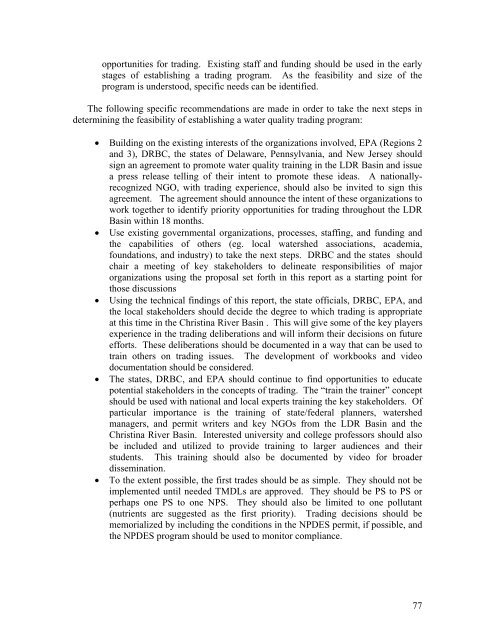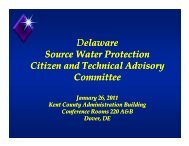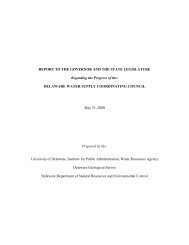Water Quality Trading in the Lower Delaware River Basin: A ...
Water Quality Trading in the Lower Delaware River Basin: A ...
Water Quality Trading in the Lower Delaware River Basin: A ...
You also want an ePaper? Increase the reach of your titles
YUMPU automatically turns print PDFs into web optimized ePapers that Google loves.
opportunities for trad<strong>in</strong>g. Exist<strong>in</strong>g staff and fund<strong>in</strong>g should be used <strong>in</strong> <strong>the</strong> early<br />
stages of establish<strong>in</strong>g a trad<strong>in</strong>g program. As <strong>the</strong> feasibility and size of <strong>the</strong><br />
program is understood, specific needs can be identified.<br />
The follow<strong>in</strong>g specific recommendations are made <strong>in</strong> order to take <strong>the</strong> next steps <strong>in</strong><br />
determ<strong>in</strong><strong>in</strong>g <strong>the</strong> feasibility of establish<strong>in</strong>g a water quality trad<strong>in</strong>g program:<br />
• Build<strong>in</strong>g on <strong>the</strong> exist<strong>in</strong>g <strong>in</strong>terests of <strong>the</strong> organizations <strong>in</strong>volved, EPA (Regions 2<br />
and 3), DRBC, <strong>the</strong> states of <strong>Delaware</strong>, Pennsylvania, and New Jersey should<br />
sign an agreement to promote water quality tra<strong>in</strong><strong>in</strong>g <strong>in</strong> <strong>the</strong> LDR Bas<strong>in</strong> and issue<br />
a press release tell<strong>in</strong>g of <strong>the</strong>ir <strong>in</strong>tent to promote <strong>the</strong>se ideas. A nationallyrecognized<br />
NGO, with trad<strong>in</strong>g experience, should also be <strong>in</strong>vited to sign this<br />
agreement. The agreement should announce <strong>the</strong> <strong>in</strong>tent of <strong>the</strong>se organizations to<br />
work toge<strong>the</strong>r to identify priority opportunities for trad<strong>in</strong>g throughout <strong>the</strong> LDR<br />
Bas<strong>in</strong> with<strong>in</strong> 18 months.<br />
• Use exist<strong>in</strong>g governmental organizations, processes, staff<strong>in</strong>g, and fund<strong>in</strong>g and<br />
<strong>the</strong> capabilities of o<strong>the</strong>rs (eg. local watershed associations, academia,<br />
foundations, and <strong>in</strong>dustry) to take <strong>the</strong> next steps. DRBC and <strong>the</strong> states should<br />
chair a meet<strong>in</strong>g of key stakeholders to del<strong>in</strong>eate responsibilities of major<br />
organizations us<strong>in</strong>g <strong>the</strong> proposal set forth <strong>in</strong> this report as a start<strong>in</strong>g po<strong>in</strong>t for<br />
those discussions<br />
• Us<strong>in</strong>g <strong>the</strong> technical f<strong>in</strong>d<strong>in</strong>gs of this report, <strong>the</strong> state officials, DRBC, EPA, and<br />
<strong>the</strong> local stakeholders should decide <strong>the</strong> degree to which trad<strong>in</strong>g is appropriate<br />
at this time <strong>in</strong> <strong>the</strong> Christ<strong>in</strong>a <strong>River</strong> Bas<strong>in</strong> . This will give some of <strong>the</strong> key players<br />
experience <strong>in</strong> <strong>the</strong> trad<strong>in</strong>g deliberations and will <strong>in</strong>form <strong>the</strong>ir decisions on future<br />
efforts. These deliberations should be documented <strong>in</strong> a way that can be used to<br />
tra<strong>in</strong> o<strong>the</strong>rs on trad<strong>in</strong>g issues. The development of workbooks and video<br />
documentation should be considered.<br />
• The states, DRBC, and EPA should cont<strong>in</strong>ue to f<strong>in</strong>d opportunities to educate<br />
potential stakeholders <strong>in</strong> <strong>the</strong> concepts of trad<strong>in</strong>g. The “tra<strong>in</strong> <strong>the</strong> tra<strong>in</strong>er” concept<br />
should be used with national and local experts tra<strong>in</strong><strong>in</strong>g <strong>the</strong> key stakeholders. Of<br />
particular importance is <strong>the</strong> tra<strong>in</strong><strong>in</strong>g of state/federal planners, watershed<br />
managers, and permit writers and key NGOs from <strong>the</strong> LDR Bas<strong>in</strong> and <strong>the</strong><br />
Christ<strong>in</strong>a <strong>River</strong> Bas<strong>in</strong>. Interested university and college professors should also<br />
be <strong>in</strong>cluded and utilized to provide tra<strong>in</strong><strong>in</strong>g to larger audiences and <strong>the</strong>ir<br />
students. This tra<strong>in</strong><strong>in</strong>g should also be documented by video for broader<br />
dissem<strong>in</strong>ation.<br />
• To <strong>the</strong> extent possible, <strong>the</strong> first trades should be as simple. They should not be<br />
implemented until needed TMDLs are approved. They should be PS to PS or<br />
perhaps one PS to one NPS. They should also be limited to one pollutant<br />
(nutrients are suggested as <strong>the</strong> first priority). <strong>Trad<strong>in</strong>g</strong> decisions should be<br />
memorialized by <strong>in</strong>clud<strong>in</strong>g <strong>the</strong> conditions <strong>in</strong> <strong>the</strong> NPDES permit, if possible, and<br />
<strong>the</strong> NPDES program should be used to monitor compliance.<br />
77




